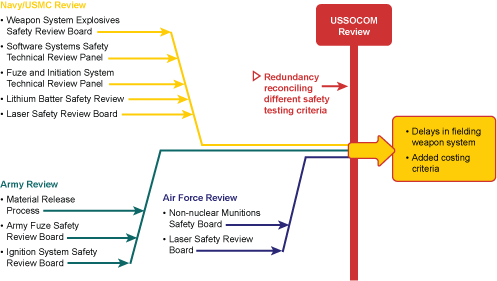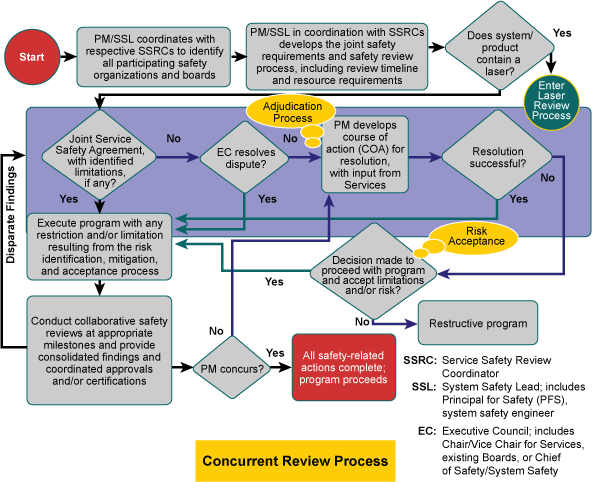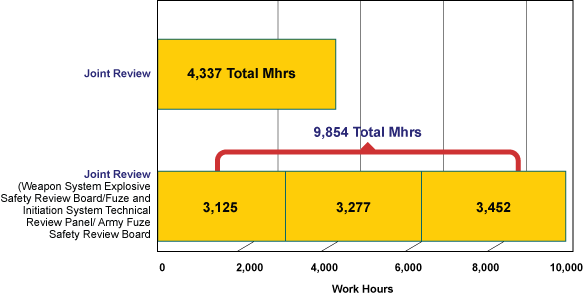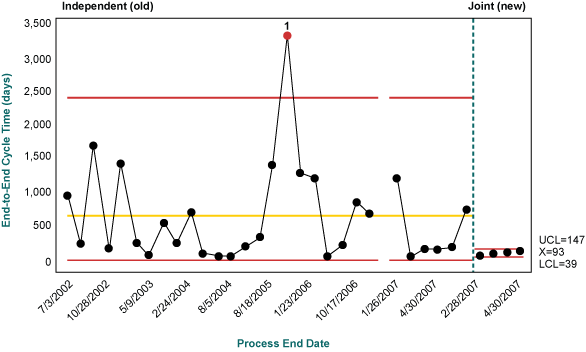
Through a two-year Six Sigma project, the Department of Defense (DoD) Acquisition and Technology Programs Task Force (ATP TF) coordinated a revision to a joint weapon system safety review process that provided a 59 percent reduction in cycle time. Without the Six Sigma framework, the project might not have achieved the success it did within the same time frame. In particular, the Six Sigma process promoted consistent, continuous communication among varied stakeholders, and it forced the project owners to create a detailed, fact-based business case that effectively persuaded stakeholders of the need for change. This ATP TF project can provide valuable lessons for others who are completing projects within the DoD.
Identifying the Problem
In 2005, the U.S. Special Operations Command (USSOCOM) approached the ATP TF with a challenge. USSOCOM weapons – by definition joint projects – required safety testing and certification by each Service’s safety review boards. This requirement created an inherent inefficiency. Not only did each Service use different safety testing criteria, but some Services had more than one safety board, each of which might have had authority to approve the program.
Some disparate tests produced redundant results while others used conflicting parameters that therefore produced incompatible data. Reviews were conducted serially rather than concurrently. This traditional approach resulted in delays in acquiring the full safety certification, in turn delaying the fielding of weapons to the warfighter. The ATP TF calculated the sigma for this process as 1.57.
The ATP TF launched an initiative to bring stakeholders together to review the USSOCOM safety certification process. The ATP TF used the DMAIC framework to structure the project. Throughout the DMAIC phases, the characteristics of the Six Sigma framework that most significantly carried the project to a successful completion were communication and a strong business case.
Communication
From the Define phase of this project through Control, communication was paramount. The Six Sigma philosophy emphasizes communication, especially through frequent, regular meetings. The meetings continue as scheduled, regardless of absences, differences or difficulties. This philosophy had an impact because in some of the early meetings the difficulties seemed insurmountable at times. Naturally, each Service had its own system and had reason to believe that it did not need guidance from other Services or from the Office of the Secretary of Defense. It was only after several discussions and consistent exchanges of views that the group began to make a breakthrough and find common ground. With each meeting, the facilitators drew more information from the key collaborators, eventually arriving at a compromise.
For example, one working group member, sensing a reluctance of participants to speak freely and offer new ideas, suggested to the Service leaders that the demand for a new process existed and was not going away. The group member stated that if the team did not come up with a recommended solution, the politics of the situation would dictate one. The group needed to consider whether it would be better to be part of the answer or have an answer given to them that they might not like. The Service participants responded to this challenge, presenting a number of new ideas for how to mold and optimize the process. Trust and communication improved with each interaction, and continues to grow as the working group moves forward with follow-on actions.
Although communication is a natural aspect of business, the fact that the Six Sigma project required regular meetings in order to fulfill the Green Belt requirements allowed the team some needed leverage. The project structure helped enforce the meeting schedule, which helped strengthen the communication.
Business Case
The second major characteristic that arose from the Six Sigma framework was the idea of the detailed business case. This requirement – largely part of the Measure phase but critical throughout all the phases – forced the project owners to gather data that presented a fact-based illustration of the status quo as well as the potential for improvement. From the beginning, the project owners understood that the group had to collect information and build a business case in order to meet the tollgates of the Six Sigma project. The business case proved critical in persuading all stakeholders of the need for collaboration. When the group members observed data relating to the redundant testing, the participants began to consider options to make the process more reasonable.
For example, project tollgate deliverables for the Analyze phase included a cause and effect diagram, illustrating the original process (Figure 1).

To help establish the problem in a quantifiable way, the project group requested that Service boards supply historical data on safety certification cycle time for Navy-led programs from the period of November 1999 through April 2007. The historical data revealed a mean cycle time of 561 days.
As the project evolved and stakeholders reviewed the business case and discussed options, they arrived at a proposed solution. In the new process (Figure 2), the lead Service for a given program would have the responsibility to obtain the safety certification for that program. That Service would then collect all the safety certification requirements from the joint Services and incorporate those requirements into one test. If there were conflicts or redundancies discovered in tests, criteria or thresholds, the Services would negotiate the terms and reach a consensus before the test took place. Instead of multiple tests, the lead Service would conduct one test with multiple criteria to satisfy all parties.

The project team chose five programs with varying degrees of complexity to compare the old and new safety review processes (Note: safety certification is not equivalent to weapon system certification):
- Non-line-of-sight (NLOS) missile system – High complexity
- Mine-resistant ambush-protected (MRAP) vehicles – High complexity
- Javelin – Medium complexity
- 60mm mortar – Medium complexity
- 30mm air-burst ammo – Low complexity
For the baseline, the team consulted the pilot programs for data on testing processes, criteria and man-hours. A defect was defined as a cycle time that exceeded 180 days.
The new process significantly reduced the amount of variation in processing time. The mean dropped from 561 days in the old process to 79 days in the new process, well under the target of 180 days. Overall, the team calculated a 59 percent reduction in cycle time and a nearly 56 percent reduction in cost (Table 1; Figures 3 and 4). The team continued the business case through the Control phase, collecting data on what redundant steps the pilot programs were able to avoid as a result of applying the new process.
| Table 1: Metrics for Old and New Safety Certification Review Processes | |||
| Measure | Independent (Old) Process | Joint (New) Process | Percentage Reduction |
| Cycle time | 243 days | 98 days | 59 |
| Cost in man-hours (MHrs) | 9,854 MHrs x $135 = $1,330,290 | 4,337 MHrs x $135 = $585,495 | 56 |


Positive Results
USSOCOM adopted the new safety certification process. The new process frees resources to work on other areas and assists in meeting the demand to field weapons on time. The change is considered so valuable that the Department is now drafting a DoD Instruction to make the new process applicable to all joint programs, not just those owned by USSOCOM.
Lessons Learned
Some important take-aways from this project:
1. Data collection requires careful advance planning. Initially, the project group was not specific enough in defining the data requested from the pilot programs and received some early data that the group could not use because of inconsistency. For example, in measuring cycle time, program managers initially used different criteria for start and end times. For some, the period began when they sent the paperwork to a Service safety board. Others interpreted the start time as the point at which the board actually began working on the request. There could be a difference of months between both of these interpretations. In some cases, a safety board might begin evaluating as soon as it receives a request, but in other cases it might have a backlog.
With only a few people recording data, defining the metrics may not be a significant problem, but with several people from different programs collecting data, the project group realized that they needed to make the definitions more clear. For purposes of this project, they wanted to measure the time it took the safety board to evaluate the request and return the approval. Therefore, they decided to define cycle time for these pilot projects to begin when the board starts evaluating the request.
2. Six Sigma can help create a strong framework for projects involving multiple stakeholders. It is essential to involve stakeholders in projects from the beginning and to collect data for a strong business case from day one. Be sure to define how to collect the data. Limit goals to clear, measurable changes that will have an impact. Above all, do not give up, even if a project has a rough start. With a highly charged issue, it could take several meetings for the communication to work and for good ideas to evolve.